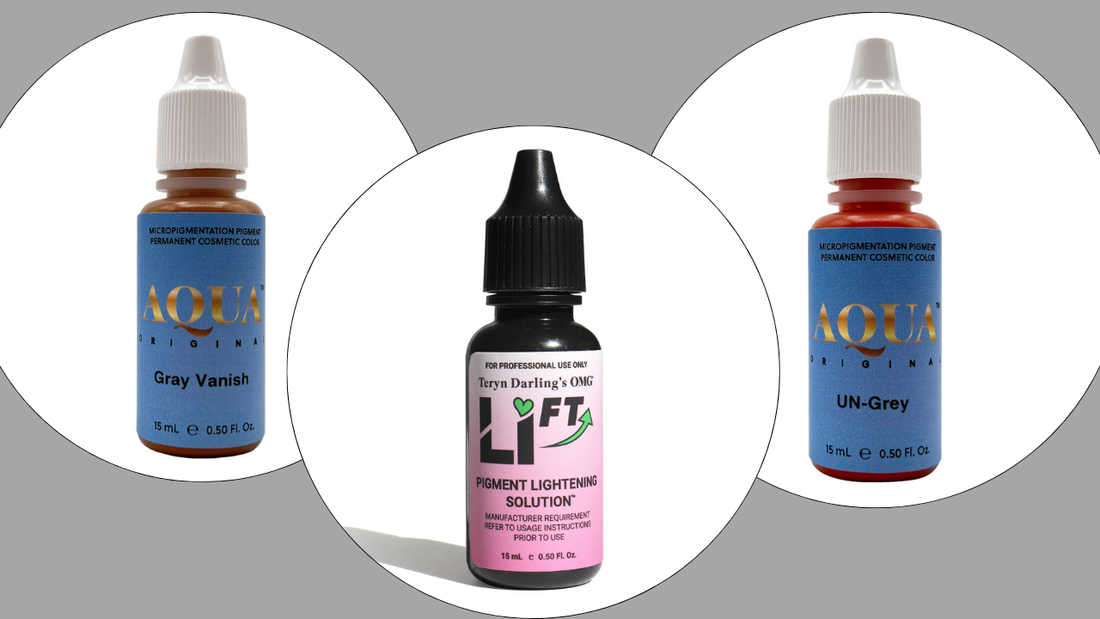
How to Decide When to Remove vs. Correct PMU
As a permanent makeup artist, one of the biggest challenges you’ll face is correcting someone else’s work. If you’ve been in this industry long enough, you’ve seen it all—blue brows, orange halos, double tails, saturated blocks, uneven shapes, and pigment piled on pigment.
When a client sits in your chair with a botched brow or bad eyeliner, the big question is:
Do I correct this with pigment correction? Or is it time for Li-FT® saline removal?
After 15+ years of correcting poorly done permanent makeup, I can confidently say—it depends. And knowing the difference is what sets skilled artists apart.


What’s the Difference Between Saline Removal and Color Correction?
Color Correction involves shifting undertones or redesigning the shape using new pigments—think warm modifiers to balance ash tones or re-mapping brows for symmetry.
Li-FT® Saline Removal is a non-laser method that lifts unwanted pigment out of the skin, making space for better work to come.
Both methods can be life-changing for a client, but the right choice comes down to one thing…
The Two Key Factors: Saturation & Shape
When you’re deciding between Li-FT® and correction, ask yourself:

1. How Saturated is the Area?
If the pigment is very dense, solid, and over-packed, correction won’t hold. Think of the skin like a glass of water—you can’t pour new pigment into a glass that’s already full. You’ve got to dump some out first.
📌 Too much pigment = Li-FT® Removal.
If the pigment is light and faded, you can usually shift the color back to a beautiful, natural tone—even if it’s gray, blue, orange, or red.
📌 Light pigment = Color Correction.
2. Is the Shape Salvageable?
If the existing work is asymmetrical, too high, too low, too thick, too close together—or has double tails—removal is the only responsible option. You can't build a masterpiece on a crooked foundation.
📌 Bad shape = Li-FT® Removal.
If the shape is decent or fixable, and saturation is light enough, you're golden. Correct that color and create a fresh, beautiful design.
📌 Good shape + light pigment = Color Correction.
Other Factors to Consider
-
How many sessions of PMU has the area had?
Skin integrity matters. -
What technique was used?
Microblading, machine shading, or combo brows will heal differently and may require different solutions. -
What brand or type of pigment was used?
Some pigments are harder to correct or remove than others.
Evaluate the full picture. This is why consultations are everything.
The #1 Mistake: Trying to Fix Oversaturation with More Pigment
Let’s say the shape is okay but the brow is way too saturated and looks like a block. If you try to tattoo over it, you’ll get:
-
Temporary improvement
-
Poor healed results
-
Fast fading
-
And that ugly color coming back again in 3 months
Why? Because there’s no room in the skin for new pigment to take. That’s why we use Li-FT® to create space. We’re not trying to remove every trace of the old tattoo—we’re trying to make space for success.
Learn How to Use Li-FT® the Right Way
If you want to build your skills and confidence as a correction artist, learning Li-FT® is a must. The Li-FT® Saline Lightening Online Course teaches you when and how to use removal safely and effectively—with full-length procedure videos, product theory, and lifetime support.
👉 Take the Li-FT® Online Course
Want to go deeper and become a true corrective expert?
The Beyond The Epidermis Course picks up where the Li-FT® course leaves off—diving into pigment behavior, skin depth, advanced corrections, and color theory.
👉 Take Beyond The Epidermis Course

FAQ: Removal vs. Correction
Q: Can I color correct over red or orange brows?
A: Yes, as long as the pigment is light and the shape is workable.
Q: Do I need to fully remove pigment with Li-FT®?
A: Not always. You just need to lift enough pigment to allow for a successful correction.
Q: How long after removal can I re-tattoo the area?
A: Usually 8–10 weeks after the last Li-FT® session, once the skin is fully healed.
Q: Can I do Li-FT® and then color correct in the same session?
A: No. These should always be separate sessions with proper healing time in between.
